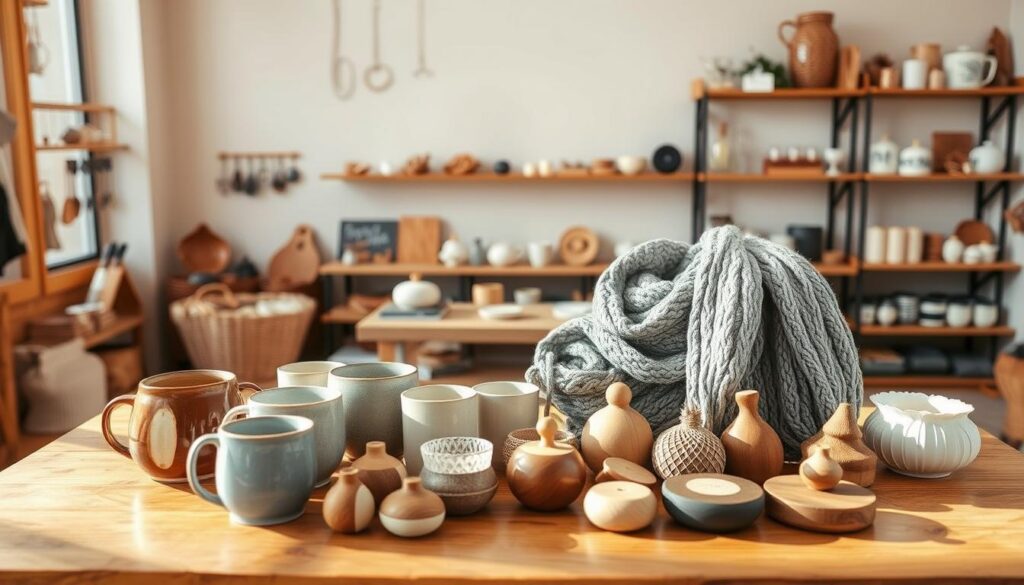As the renowned entrepreneur, Sophia Amoruso, once said, “The most successful people are those who are willing to take a chance on something they believe in.” This quote resonates deeply with aspiring entrepreneurs looking to turn their passion for crafting into a thriving online business. Selling handmade goods online has evolved from ancient trade practices, like the exchange of salted fish for fur, to the vast opportunities offered by modern e-commerce.
Today, small businesses can flourish by transitioning from traditional craft shows to online platforms. The minimal upfront investment required to start a handmade business from home makes it an accessible venture for many. However, success lies in choosing the right platforms and strategies to showcase your craft effectively.

Whether you’re creating unique jewelry, knitted garments, or artisanal home decor, understanding the best platforms and strategies is crucial. This guide aims to help creatives navigate the digital marketplace, ensuring their handmade items reach a global audience.
Key Takeaways
- Starting a handmade business online requires minimal upfront investment.
- Choosing the right platform is essential for maximizing your product’s visibility.
- Historical trade practices have evolved into modern e-commerce opportunities.
- Understanding your target audience is key to successful sales strategies.
- Diversifying sales channels can lead to increased revenue and customer loyalty.
Overview of the Handmade Marketplace
The evolution of handmade marketplaces is a fascinating journey that spans centuries. From ancient barter systems, where items like salted fish were exchanged for wooden toys, to today’s digital platforms, the way artisans sell their crafts has transformed significantly.
Historical Perspectives and Evolution
Traditionally, handmade goods were sold through local craft fairs and markets. These physical spaces allowed artisans to connect directly with customers, fostering a sense of community and personalized service. The rise of the internet marked a turning point, enabling the creation of online marketplaces that could reach a global audience.
Modern Trends and Opportunities
Today, platforms like Etsy and Amazon Handmade dominate the digital landscape. These sites offer artisans the tools to showcase their products, manage inventory, and analyze sales trends. The shift from physical to digital marketplaces has opened up new opportunities, allowing small businesses to thrive without the need for a physical storefront.
Understanding this evolution is key to blending tradition with modern business practices. By leveraging historical insights and embracing new technologies, artisans can create successful strategies for selling their handmade items in today’s competitive marketplace.
Hot Online Marketplaces for Your Handmade Goods
Discover the premier platforms where artisans can showcase their unique creations to a global audience. Leading marketplaces like Etsy and Amazon Handmade offer unparalleled opportunities for makers to connect with millions of customers worldwide.
Etsy & Amazon Handmade Spotlight
Etsy stands out as a haven for artisans, with over 33 million active buyers eager for unique items. This platform is ideal for those seeking to sell custom-made art, gifts, and more. Amazon Handmade, on the other hand, reaches an impressive 250 million customers, making it a powerful tool for expanding your craft’s global presence.
Both platforms offer features that empower sellers. For instance, Etsy’s vacation mode allows you to pause your shop during breaks, while Amazon Handmade provides valuable analytics to track your sales performance. These tools help you manage your business efficiently and make data-driven decisions.
Subscription boxes are becoming a popular trend, offering a recurring revenue stream. By curating a themed box of your art or crafts, you can attract loyal customers. Additionally, both platforms thrive on unique, custom-made items, making them perfect for selling personalized gifts and art.

Whether you’re focusing on Etsy, Amazon Handmade, or exploring other niche platforms, these marketplaces provide the visibility and tools needed to grow your business. Embrace these opportunities to turn your passion into a thriving online venture.
Subscription Boxes and Niche Platforms for Crafters
Subscription boxes have become a popular way for crafters to build a steady income stream. These curated boxes allow makers to deliver unique, crafted items directly to customers each month, fostering loyalty and repeat business. Platforms like Cratejoy specialize in subscription commerce, offering tools to create and manage these recurring deliveries effectively.
Niche platforms are another powerful tool for crafters. These platforms cater to specific audiences, such as eco-friendly products or baby items, helping you connect with customers who truly value your craft. For example, platforms focused on eco-friendly goods attract environmentally conscious buyers, creating a loyal community around your products.
When choosing a subscription model, consider your product style and audience. Some platforms offer pre-designed boxes, while others let you customize every detail. By leveraging both subscription and niche options, you can expand your market reach and build a sustainable online business.
Handmade Goods: Product Presentation and Photography Tips
When it comes to selling your creations online, the first thing customers notice is the visuals. High-quality images can make a significant difference, boosting your sales by up to 30%. But how do you ensure your product photography stands out?
Lighting and Styling Techniques
Natural light is your best friend. Position your product near a window to capture soft, even lighting. If natural light isn’t available, invest in a simple DIY setup with a white background and reflectors. For example, a white poster board and foam boards can create professional-looking results without breaking the bank.
Styling is equally important. Keep backgrounds clean and use props that complement your product. For jewelry, a velvet tray can add elegance, while a woven basket might suit rustic items. Experiment with angles—shoot from above, at eye level, or slightly below to add variety.
Storytelling Through Imagery
Every image should tell a story. Lifestyle shots, showing your product in use, help customers imagine owning it. For instance, a photo of a person wearing your handmade necklace can create an emotional connection. Detailed shots are also crucial, especially for intricate designs, allowing customers to see the craftsmanship up close.
“The goal of product photography is to create an emotional connection that drives action.” — Alexandra Gorn
Investing time in staging and photography pays off. High-quality visuals not only attract customers but also build trust in your brand. Remember, the first impression is often visual, so make it count.

Innovative Branding and Packaging Ideas
Creating a strong brand identity is crucial for any business looking to stand out in today’s competitive market. One of the most effective ways to achieve this is through innovative branding and packaging. These elements not only enhance the visual appeal of your product but also create a lasting impression on your customers.
Unforgettable Unboxing Experiences
Unboxing experiences have become a key factor in customer satisfaction and brand loyalty. When a product arrives in unique and creative packaging, it can turn a routine purchase into an exciting event. For example, using custom labels or presenting your product in a Mason jar can elevate your brand’s perception and make it more memorable.
- Branding Consistency: Ensure your packaging reflects your brand’s identity consistently across all products.
- Creative Packaging Ideas: Consider eco-friendly materials or personalized touches to make your packaging stand out.
- Memorable Unboxing: Design your packaging to create an emotional connection, encouraging customers to share their experience.
“The goal of packaging is to create an emotional connection that drives customer loyalty.” — Alexandra Gorn
By focusing on innovative branding and unique packaging, you can differentiate your business and build a loyal customer base. Remember, the unboxing experience is the first physical interaction customers have with your product, making it a critical touchpoint for your brand.

Setting Up an Optimized Online Store
Creating an online store is a crucial step in turning your crafting passion into a business. With the right setup, your store can attract more customers and boost sales. Let’s explore how to build a store that works well and looks great.
Leveraging Print-On-Demand and Fulfillment Apps
Print-on-demand services like Printful and Teelaunch can save you time and money. They handle printing, inventory, and shipping, letting you focus on creating and selling. These apps work with platforms like Shopify, making it easy to run your store from home.

Designing for User Engagement
Your website design should be clean and easy to navigate. Use high-quality images and lifestyle shots to show your products in use. For example, a photo of someone wearing your jewelry can help customers imagine owning it.
Cost-Effective Methods to Start from Home
You don’t need a big budget to start. Platforms like Shopify and WooCommerce offer affordable plans. SEO optimization is also key—use niche keywords to attract the right customers. Learn more about creating a handmade crafts business online.
- Use print-on-demand to reduce inventory costs.
- Choose a website design that’s easy to navigate.
- Start small and grow as you learn.
By following these tips, you can create a store that’s both attractive and functional, helping you succeed in the online market. For more DIY ideas to make money from home, visit Mizmoolah.
Crafting a Social Media Strategy for Your Art
Social media is a powerful tool for artists and crafters to showcase their work, connect with customers, and build a loyal community. Platforms like Instagram, Pinterest, and Facebook offer unique opportunities to share your craft and reach a global audience. By leveraging these channels effectively, you can drive traffic to your online store, increase brand visibility, and foster meaningful connections with your audience.
Engaging Your Audience
Engaging your audience is key to building a strong online presence. Share behind-the-scenes content, like how you create your art or the inspiration behind your craft. Use high-quality images and videos to showcase your work in action. Interactive content, such as polls or Q&A sessions, can also help you connect with your audience on a deeper level.
Storytelling is another effective way to engage your audience. Share the story behind your art, whether it’s the materials you use or the meaning behind a particular piece. This helps customers connect emotionally with your work, making them more likely to purchase from you.
Collaborations and Influencer Partnerships
Collaborating with influencers or complementary brands can significantly expand your reach. Partner with influencers who align with your brand values to showcase your art to their followers. This can lead to increased visibility and credibility for your craft business.
When working with influencers, ensure the partnership feels authentic. Choose influencers who genuinely appreciate your craft, as their enthusiasm will resonate with their audience. Collaborations can also include co-creating products or hosting joint giveaways, which can drive engagement and attract new customers.

To further enhance your social media strategy, consider the following tips:
- Use platforms like Instagram and Pinterest to showcase your art through high-quality visuals.
- Post consistently to keep your audience engaged and interested in your craft.
- Engage with your followers by responding to comments and messages promptly.
For more ideas on how to monetize your craft, visit Mizmoolah for inspiration and resources.
Ensuring Product Quality and Compliance
Maintaining high standards is essential for any craft business aiming to build a loyal customer base. Quality control ensures your products are safe, consistent, and meet customer expectations. This process not only builds trust but also helps you avoid costly issues down the line.
Start by setting up internal processes that ensure product safety and consistency. For example, follow the plan-do-check-act (PDCA) model: plan your quality goals, implement them, check the results, and act on improvements. This structured approach helps minimize errors and reduces costs associated with rework.

Legal considerations are just as important. Familiarize yourself with regulations like FDA guidelines for cosmetics and CPSC standards for children’s products. For instance, if you make handmade soaps, ensure your ingredients are sourced properly and comply with safety standards. Consulting with experts can help you navigate these complex requirements.
Obtaining certifications and documenting your quality control measures can also boost credibility. For example, creating a quality manual or inspection checklist helps maintain consistent standards. Remember, rigorous quality control builds customer trust and supports long-term growth.
Real Success Stories from Handmade Entrepreneurs
Real-life success stories from entrepreneurs who turned their passions into thriving businesses offer valuable insights and inspiration. These tales of triumph highlight the power of innovation, persistence, and strategic thinking in the handmade sector.
Case Study: Jewelry and Bath Bombs
Wendy, the founder of Flannel Board Fun, transformed her passion for creating educational tools into a successful business. Starting as a preschool teacher, she began selling felt boards at craft markets and on Etsy. Her big break came during the COVID-19 pandemic when schools and libraries sought virtual props, boosting her web presence significantly. Today, her Etsy shop accounts for 75% of her sales, while her website contributes 25%. Wendy’s strategy includes email marketing, which boasts high open rates, and Pinterest, where she started creating pins in 2015 to drive traffic to her blog. She also expanded into digital products, offering patterns for her felt sets, which has helped increase her revenue and impact on children’s literacy.

Case Study: Traditional Crafts in Action
Royalty Soaps is another shining example of success. This brand built a loyal customer base by focusing on natural ingredients and eco-friendly packaging. By leveraging social media platforms like Instagram and Pinterest, they showcased their products through high-quality visuals and engaging content. Their strategy included behind-the-scenes stories and customer testimonials, which helped build trust and attract a following. Royalty Soaps’ emphasis on unique, small-batch products resonated with buyers seeking personalized and sustainable options. Their success story underscores the importance of aligning brand values with customer preferences and using creative strategies to stand out in a competitive market.
Your Next Steps for Handmade Success Online
Turning your craft into a thriving online business is within reach. Start by choosing the right platform—whether it’s Etsy, Shopify, or a subscription-based model like Cratejoy. Each offers unique tools to help you succeed.
Take these next steps:
– Set up your online store with a platform that fits your needs.
– Invest in high-quality product photos to showcase your work.
– Develop a social media strategy to connect with your audience.
– Explore subscription boxes for recurring revenue.
– Learn about launching a craft business with resources like Shopify’s guide.
Remember, every maker can build a successful online business with the right strategy. Start today and turn your passion into a thriving venture!








